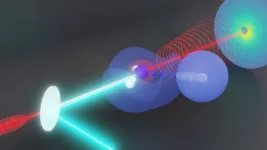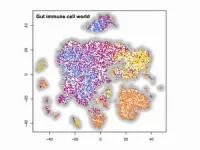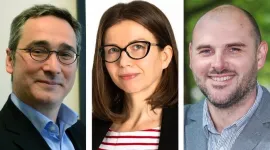(Press-News.org) Scientists have caught fast-moving hydrogen atoms – the keys to countless biological and chemical reactions – in action.
A team led by researchers at the Department of Energy’s SLAC National Accelerator Laboratory and Stanford University used ultrafast electron diffraction (UED) to record the motion of hydrogen atoms within ammonia molecules. Others had theorized they could track hydrogen atoms with electron diffraction, but until now nobody had done the experiment successfully.
The results, published October 5 in Physical Review Letters, leverage the strengths of high-energy Megaelectronvolt (MeV) electrons for studying hydrogen atoms and proton transfers, in which the singular proton that makes up the nucleus of a hydrogen atom moves from one molecule to another.
Proton transfers drive countless reactions in biology and chemistry – think enzymes, which help catalyze biochemical reactions, and proton pumps, which are essential to mitochondria, the powerhouses of cells – so it would be helpful to know exactly how its structure evolves during those reactions. But proton transfers happen super-fast – within a few femtoseconds, one millionth of one billionth of one second. It’s challenging to catch them in action.
One possibility is to shoot X-rays at a molecule, then use the scattered X-rays to learn about the molecule’s structure as it evolves. Alas, X-rays only interact with electrons – not atomic nuclei – so it’s not the most sensitive method.
To get to the answers they were looking for, a team led by SLAC scientist Thomas Wolf, put MeV-UED, SLAC's ultrafast electron diffraction camera to work. They used gas-phase ammonia, which has three hydrogen atoms attached to a nitrogen atom. The team struck ammonia with ultraviolet light, dissociating, or breaking, one of the hydrogen-nitrogen bonds, then fired a beam of electrons through it and captured the diffracted electrons.
Not only did they catch signals from the hydrogen separating from the nitrogen nucleus, they also caught the associated change in the structure of the molecule. What’s more, the scattered electrons shot off at different angles, so they could separate the two signals.
“Having something that’s sensitive to the electrons and something that’s sensitive to the nuclei in the same experiment is extremely useful,” Wolf said. “If we can see what happens first when an atom dissociates – whether the nuclei or the electrons make the first move to separate – we can answer questions about how dissociation reactions happen.”
With that information, scientists could close in on the elusive mechanism of proton transfer, which could help to answer myriad questions in chemistry and biology. Knowing what protons are doing could have important implications in structural biology, where traditional methods like X-ray crystallography and cryo-electron microscopy have difficulty “seeing” protons.
In the future the group will do the same experiment using X-rays at SLAC’s X-ray laser, the Linac Coherent Light Source (LCLS), to see just how different the results are. They also hope to up the intensity of the electron beam and improve the time resolution of the experiment so that they can actually resolve individual steps of proton dissociation over time.
The research was funded in part by the DOE Office of Science. MeV-UED is an instrument of SLAC’s LCLS X-ray laser facility. LCLS is a DOE Office of Science user facility.
END
Researchers catch protons in the act of dissociation with SLAC’s ultrafast 'electron camera'
2023-10-06
ELSE PRESS RELEASES FROM THIS DATE:
Scientists investigate Grand Canyon's ancient past to predict future climate impacts
2023-10-06
The Grand Canyon’s valleys and millions of years of rock layers spanning Earth’s history have earned it a designation as one of the Seven Natural Wonders of the World. But, according to a new UNLV and University of New Mexico study, its marvels extend to vast cave systems that lie beneath the surface, which just might hold clues to better understand the future of climate change — by studying nature’s past.
A research team led by UNLV paleoclimatologist and Professor Matthew Lachniet that included the University of New Mexico Department of Earth & Planetary Sciences Distinguished Professor Yemane Asmerom and Research Scientist Victor Polyak and other ...
ESMO Congress 2023
2023-10-06
Lugano, Switzerland, 6 October 2023 – Under the promise to “Disseminating innovative research for optimal cancer care” as this year’s tagline reads, the ESMO Congress 2023 will be held in Madrid between 20-24 October 2023 with a virtual component to allow as many people as possible to attend.
From a keynote lecture pinpointing the hallmarks of cancer in the current year through the reinforced commitment towards more academic input in the drug development process for better cancer care, and then further down to the dramatic scenarios brought by the too many situations of crisis in the world which have an unbearable impact ...
ORNL, University of Texas Rio Grande Valley partner to provide students research, mentorship opportunities
2023-10-06
The Department of Energy’s Oak Ridge National Laboratory and the University of Texas Rio Grande Valley, known as UTRGV, have signed a memorandum of understanding to strengthen research cooperation and establish a collaborative program for undergraduate research and education, further cementing relationships and collaboration between the lab and minority-serving institutions. This partnership builds a pathway for students to pursue science, technology, engineering and mathematics, or STEM, careers through DOE by complementing ...
Lurbinectedin for Neuroendocrine Tumors (NETs)
2023-10-06
“Several ongoing trials hope to further elucidate the role of lurbinectedin in highgrade neuroendocrine neoplasms [...]”
BUFFALO, NY- October 6, 2023 – A new editorial paper was published in Oncoscience (Volume 10) on June 14, 2023, entitled, “Lurbinectedin, a DNA minor groove inhibitor for neuroendocrine neoplasms beyond small cell lung cancer.”
In their new editorial, researchers Deepak Bhamidipati and Vivek Subbiah from the Sarah Cannon Research Institute discuss lurbinectedin as a method to treat neuroendocrine tumors (NETs). NETs encompass a variety ...
Clinical trial reveals benefits of inhaled nitric oxide for patients with respiratory failure due to COVID-19 pneumonia
2023-10-06
Key Takeaways
Researchers have posted the results of a multisystem phase II clinical trial of patients with COVID-19 and respiratory failure
Patients who received inhaled nitric oxide had improved blood oxygen levels and fewer risks of long-term sensory and motor neurologic symptoms
They also experienced a faster reduction of viral load in sputum and blood
BOSTON – Inhaled nitric oxide gas widens blood vessels in the lungs and is used to treat severe cardio-pulmonary conditions in newborns and adults.
A recent multicenter international ...
nTIDE September 2023 Jobs Report: Employment trend holds steady at historic highs through early autumn for people with disabilities
2023-10-06
East Hanover, NJ – October 6, 2023 –The labor force participation and employment-to-population ratio have held relatively steady throughout the summer and into the fall for people with disabilities, while percentages for people without disabilities may have maxed out at their pre-pandemic baseline, according to today’s National Trends in Disability Employment – semi-monthly update (nTIDE), issued by Kessler Foundation and the University of New Hampshire’s Institute on Disability (UNH-IOD). In comparison, the employment-to-population ratio for people without disabilities remained flat with no change, while ...
Kidney disease gene also has a protective mutation
2023-10-06
African Americans have long been known to be at increased risk of kidney disease due to a dangerous genetic mutation that creates a hole in the kidney cells, but Vanderbilt University Medical Center (VUMC) researchers have now discovered a protective genetic mutation that covers the hole to eliminate the risk.
The findings on the apolipoprotein L1 (APOL1) gene, published today in the Journal of the American Society of Nephrology, could have immediate and broad implications for kidney health because people with both the disease-causing and protective mutation are not at increased risk.
“Our team discovered ...
Aston University offers talented Indian graduates opportunity to study for Masters degrees
2023-10-06
Aston University, UK, is offering a group of highly talented graduates of Symbiosis Institute of Technology (SIT), India the opportunity to study for a Masters degree.
The two institutions have signed a progression agreement which is designed to make it easier for top SIT graduates to apply for courses at Aston University.
The Aston-SIT partnership has been developed from the support of the British Council via its going global partnerships exploratory grant scheme. The areas of study cover a wide range of MSc programmes in engineering, physical sciences and business studies.
Aston University is in Birmingham, ...
New research led by Mays Cancer Center reveals how mutations in BRCA1 affect cancer susceptibility in women
2023-10-06
SAN ANTONIO, Oct. 6, 2023 – Three decades after discoveries linking mutations in the BRCA1 gene to breast and ovarian cancer susceptibility, research led by Mays Cancer Center at The University of Texas Health Science Center at San Antonio (UT Health San Antonio) has pinpointed the molecular mechanism by which a large portion of these mutations cause cancers in women.
The discovery, unveiled in an Oct. 4 research article in the journal Molecular Cell, is poised to assist researchers in developing drugs to battle breast and ovarian cancers and to help identify women who are at an elevated risk of developing these cancers, according to the ...
How the war in Ukraine is challenging two academic disciplines
2023-10-06
Since the beginning of Russia’s invasion of Ukraine, two academic disciplines have come to fore: peace and conflict studies and East European studies. Experts from both fields represent important voices in the public discourse. A symposium entitled ‘War and Peace in Ukraine: Reflecting, Studying and Engaging Across Disciplines” will be held from 12 until 13 October 2023 at Bielefeld University. It brings together experts from both fields in order to discuss the relationship between them and challenges of participating in a highly ...









